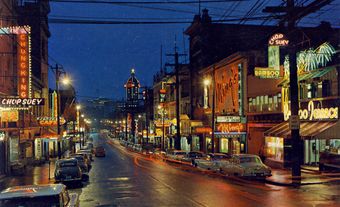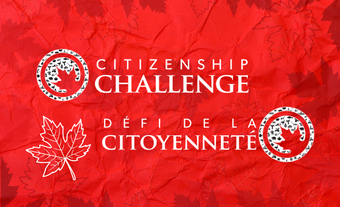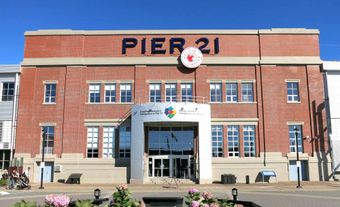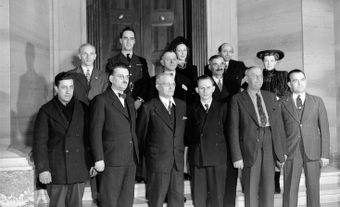Robert England, teacher, railway administrator, civil servant (born 15 September 1894 in Portadown, Northern Ireland; died 14 June 1985 in Victoria, BC). England had a varied education and an even more varied career. However, his contributions to Canadian society were primarily in the fields of rural education, immigration and cultural pluralism, veterans’ rehabilitation and citizenship.
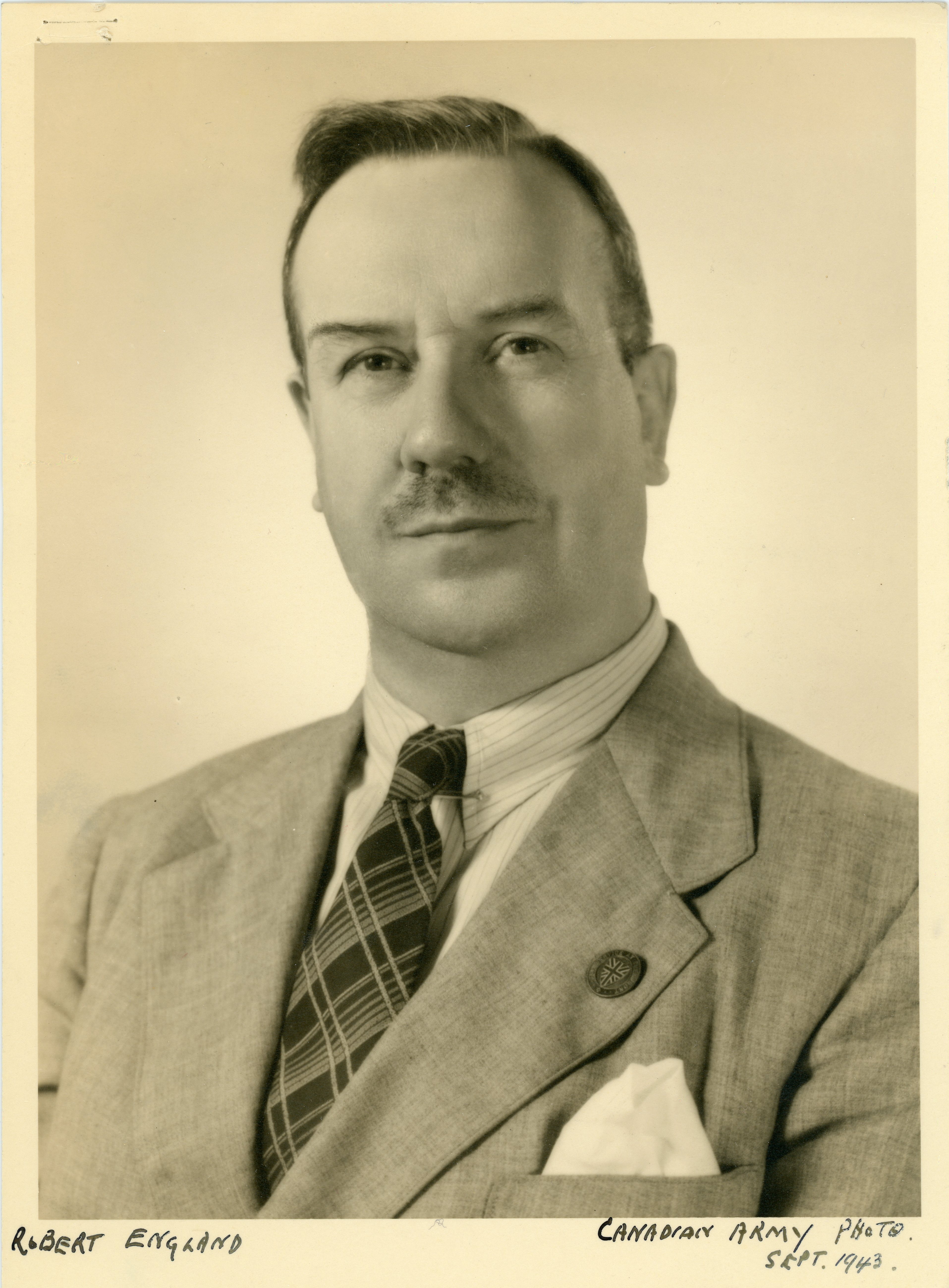
Early Life and Education
Robert England was the thirteenth child born to Elizabeth and David England. At 16, England began training to teach elementary school. Two years later, he abandoned these studies and made plans to become a Methodist minister. However, he balked at the Methodist Church’s decision to send him out as a probationary minister instead of enrolling him in college. He decided instead to emigrate to Canada. He arrived in 1914 and did farm work and a variety of odd jobs in Saskatchewan before enrolling in Queen’s University as an extramural student.
First World War Service
In 1915, Robert England enlisted in the armed forces and went overseas with the Canadian Expeditionary Force. He fought in the battles of Vimy Ridge, Hill 70 and Cambrai (where he was awarded the military cross) and twice was seriously wounded. In February 1919 he married Amy Marion Hale, a nurse who had attended to him while he was hospitalized in London, England. (Three years after Amy’s death in 1966, England married Thelma Thomson.) In July 1919, he was discharged at Regina, Saskatchewan and immediately went to work on a farm for the harvest season. However, his injuries prevented him from continuing this type of manual labour, so that fall he returned to Queen’s University to complete his studies.
Teaching
Upon graduation from Queen’s, Robert England set out to teach in Slawa, a primarily Ukrainian settlement in rural Saskatchewan (where he stayed from 1920–23). He believed that teaching was nation-building, a work of assimilating immigrants into Canadian society. Acting from this belief, in Slawa England practiced and promoted the idea that the school ought to be a community centre. By this, he meant it ought to be integrated with the local agricultural economy, teach a practical curriculum, offer night classes for adults, promote extracurricular activities and involve local citizens who had relevant skills to offer.
His efforts attracted attention in the press. He was invited to speak at provincial teachers’ conventions, and his school eventually became the subject of a 1921 documentary film by the provincial government, Nation Building in Saskatchewan: The Ukrainians. However, his ambitions extended beyond the classroom, and so in 1923 he successfully applied for a Saskatchewan Government Paris Scholarship and moved to France. There he spent a year studying at the Collège Libre de Sciences Sociales, where he wrote a thesis on the assimilation of Ukrainians in Canada and was awarded a Certificat d’Études Sociales.
Immigration and Cultural Pluralism
Shortly after graduating from the Collège, Robert England was recruited by the Canadian National Railways to work in the newly formed Department of Colonization and Agriculture. He worked first in Europe as a Continental Superintendent (1924–30) and then in Winnipeg as a Western Manager of Colonization and Agriculture (1930–36). In 1934, he earned a Master’s degree in economics from Queen’s University with a thesis on “The Colonization of Western Canada” (later published as a book of the same title).
During this period, he was an outspoken voice in the ongoing and at times heated debate about the immigration and assimilation of continental Europeans in Canada. Notably, he was one of the few people engaged in these debates who was actively involved in immigration and settlement work. In addition to delivering numerous addresses and penning several articles, he also published two influential and widely read books, The Central European Immigrant in Canada (1929) and The Colonization of Western Canada (1936). Having earned a reputation as an expert on the subject, England was then asked by the CBC to produce a radio series about the ethnic groups in western Canada; Ventures in Citizenship aired in 1938.
England’s early position was alarmist. He suggested that immigration be halted and concerted efforts be made to assimilate existing continental European immigrants. However, by the close of the 1920s he openly rejected the idea of hierarchy among what were then called European “races” and called for cooperation and tolerance between Anglo-Canadians and newcomers. This position marked him as one of the more progressive voices in the debates of the era. His philosophy of cultural pluralism was encapsulated in the one line that he repeatedly quoted: “God has written a line of his thought on the cradle of each race.”
But England’s philosophy of cultural pluralism was not only racially essentialist; it was also racially exclusionary. His efforts to promote pluralism were limited to celebrating the contributions of European immigrants. He excluded all those racialized as non-white, particularly peoples of African, Asian or Indigenous descent. He also had no qualms about the settler colonial work of his department, arguing in 1929 that Indigenous peoples’ alleged “neglect to build” justified their dispossession by Europeans. And even when it came to European immigrants, he cautioned that they ought to drawn from the “better eugenic types.” (See also Eugenics in Canada.)
Work with Veterans
In 1936, Robert England made the unexpected move of leaving the CNR. He went to work for the University of British Columbia as the director of extension services and associate professor of economics (1936–37). The next year, he returned to Winnipeg to work as an economic advisor to the Winnipeg Electric Company.
From 1940 until the end of the Second World War, he held a number of temporary positions in the civil service. Specifically, he assisted with veterans’ education and rehabilitation, working first with the Canadian Legion and later a variety of branches of the civil service. Combining his day-to-day work with broader academic study, he published numerous articles and two books on the subject: Discharged: A Commentary on the Civil Re-Establishment of Veterans in Canada (1943) and, enabled by a Guggenheim Fellowship (1945–46), Twenty Million World War Veterans (1950). Perhaps his greatest service during this period was as a columnist for the Winnipeg Free Press, where he contributed over a hundred articles on veterans’ problems and replied to over a thousand letters from veterans. For his efforts in laying the foundation for Canada’s civil reestablishment program, England was awarded an honorary Doctor of Laws from the University of Manitoba in May 1948.
Promoting Citizenship
At the heart of Robert England’s educational efforts was the idea of citizenship. For him, citizenship was more a civic ideal and less a category of belonging; it was an attitude that was expressed through “public-spiritedness.” Citizenship in democracy for England was about consent, conservation, contribution and cooperation, all made possible by courtesy and perhaps a “dash of Christianity.” However, he also believed that formal citizenship was important. In the early 1920s, he suggested that citizenship ought to be granted to immigrants who could demonstrate literacy and who could pass an exam on the nature and origins of Canada’s levels of government. Preferably, they would also perform some service work to demonstrate they were truly desirous of citizenship. He suggested that once all this was completed, a ceremony ought to be held in which each new citizen was issued a certificate of naturalization, signed by a representative of the British Crown. (See also Canadian Citizenship.)
England returned to these ideas during the Second World War. From 1942–43 he sat on the Committee on Cooperation in Canadian Citizenship, a group consisting of a dozen members of the public, brought together to advise federal government departments on questions relating to so-called foreign language-speaking groups in Canada. The group was rather ineffectual, as was the “Nationalities Branch,” an administrative body created to provide administrative support to the larger committee.
In 1944, England was tasked with assessing the Nationalities Branch and providing recommendations as to its future. In his subsequent report, he suggested the Nationalities Branch be transformed into a Citizenship Division, which could then create a citizenship training program, inaugurate a citizenship ceremony and provide a clear definition of a Canadian citizen. Although it is unclear if his report was directly responsible (at least one of his contacts suggested it was), many of England’s hopes were realized in 1946 when Paul Martin Sr. announced the Canadian Citizenship Act. The new legislation came into effect on 1 January 1947 and kicked off a week-long official celebration of citizenship across the country, beginning with a national ceremony sponsored by the new Citizenship Branch of the state department.
In a final act of public-spirited citizenship, England left his estate to the University of British Columbia, with instructions that the funds be used to further what he called “dis-interested education.” This was, he specified, learning that was not specifically devoted to gaining academic credits, diplomas or degrees, or acquiring professional status.

 Share on Facebook
Share on Facebook Share on X
Share on X Share by Email
Share by Email Share on Google Classroom
Share on Google Classroom
